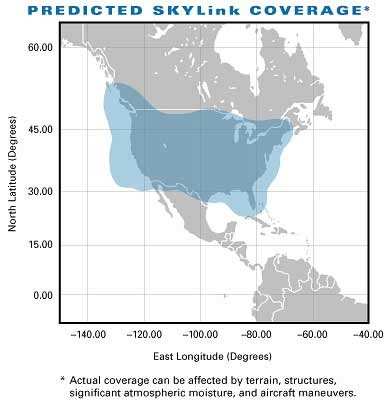Wed, Sep 22, 2004
But Where Will We Get The Bandwidth?
 As the world's airlines this week
view new in-flight passenger services with big bandwidth
requirements, ARINC Incorporated is showing where they can get all
that in-flight bandwidth -- and how to add valuable services for
the flight deck at the same time.
As the world's airlines this week
view new in-flight passenger services with big bandwidth
requirements, ARINC Incorporated is showing where they can get all
that in-flight bandwidth -- and how to add valuable services for
the flight deck at the same time.
ARINC is demonstrating its Commercial SKYLink broadband solution
with a live Ku-band satellite link in operation at Booth 323 of the
World Airline Entertainment Association (WAEA) 2004 convention in
Seattle (WA). The live SKYLink satellite demo includes a range of
passenger applications and 802.11b/g wireless Internet access.
 If you're at the convention, ARINC
says go ahead and bring your Wi-Fi laptop and PDA to Booth 323 and
"log on" wirelessly to the fully operational satellite connection
to send and receive e-mails or surf the Internet. ARINC has
integrated SKYLink with several most-wanted passenger services and
it can also deliver applications for the electronic cockpit, such
as graphical weather information for display on electronic flight
bags.
If you're at the convention, ARINC
says go ahead and bring your Wi-Fi laptop and PDA to Booth 323 and
"log on" wirelessly to the fully operational satellite connection
to send and receive e-mails or surf the Internet. ARINC has
integrated SKYLink with several most-wanted passenger services and
it can also deliver applications for the electronic cockpit, such
as graphical weather information for display on electronic flight
bags.
"Whether the end user is a co-pilot or a passenger, SKYLink
provides the inflight bandwidth tomorrow's applications will need,"
said Senior Director Tom Mullan. "We are holding active discussions
with several airlines. Commercial SKYLink is smaller, cheaper,
lighter and more capable than competing inflight solutions."
ARINC says a major selling point of Commercial SKYLink is the
compact hardware package itself; just 150 pounds including its
low-profile antenna. ARINC says that means lower aerodynamic drag
and significant fuel savings over the satellite broadband
competition.
Commercial SKYLink is built on ARINC's successful broadband
technology for business aircraft, but offers 100% more bandwidth --
5 Mbps to the aircraft and 256 Kbps off-aircraft. SKYLink satellite
coverage went live over North America in April, and
SKYLink-equipped business jets now have 2-way satellite broadband
service from coast to coast on the SES Americom Ku-band satellite
constellation. Coverage expansion is planned in 2005 to include the
North Atlantic routes, Europe, and the Middle East.

"Carriers thinking about Ku-band satellite broadband can keep
all their options open with SKYLink," said Mullan. "We have
optimized the design for retrofit, and unlike rigid OEM approaches
we have kept SKYLink a highly configurable system to meet any
foreseeable fleet requirements. We can even deliver our compact
SKYLink business jet solution for low-cost carriers seeking to
minimize the cost and footprint of broadband."
More News
From 2023 (YouTube Edition): "Ain’t Your Daddy’s Super Cub”—Don Wade Co-owned by Don and Ron Wade—the former of Don’s Dream Machines, a storied >[...]
Pilot-Rated Passenger Reported That The Pilot Did Not Adequately “Round Out” The Landing Flare And The Airplane Bounced And Yawed To The Right Analysis: The pilot state>[...]
Dead Reckoning Dead reckoning, as applied to flying, is the navigation of an airplane solely by means of computations based on airspeed, course, heading, wind direction, and speed,>[...]
Aero Linx: Lake Amphibian Club This website is created and sponsored by the Lake Amphibian Club, to help spread the word about these wonderful, versatile amphibians that can land j>[...]
“I am deeply honored to be sworn in as NASA administrator. NASA’s mission is as imperative and urgent as ever — to push the boundaries of human exploration, ignit>[...]
 Classic Aero-TV: In Praise of Alabamas Patriot Aircraft USA
Classic Aero-TV: In Praise of Alabamas Patriot Aircraft USA NTSB Final Report: Cirrus Design Corp SR22
NTSB Final Report: Cirrus Design Corp SR22 ANN's Daily Aero-Term (12.21.25): Dead Reckoning
ANN's Daily Aero-Term (12.21.25): Dead Reckoning ANN's Daily Aero-Linx (12.21.25)
ANN's Daily Aero-Linx (12.21.25) Aero-News: Quote of the Day (12.21.25)
Aero-News: Quote of the Day (12.21.25)





